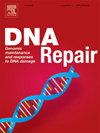Transcription-coupled repair of crosslinking DNA damage
IF 2.7
3区 生物学
Q2 GENETICS & HEREDITY
引用次数: 0
Abstract
Impediments to faithful transcription must be resolved to ensure accurate gene expression and safeguard normal cellular function. Dedicated DNA repair pathways have therefore evolved to remove transcription-blocking DNA damage, targeted to active genes. Although significant research efforts to date have focussed on the transcription-coupled repair of bulky, UV-induced DNA damage, it is known that other forms of DNA damage can perturb RNA Polymerase II progression. Only in recent years has insight into these pathways emerged, despite the clinical significance of understanding all transcription-coupled repair pathways. These recent observations have highlighted substantial molecular differences in these pathways compared to the canonical UV-damage repair mechanisms. This review summarises our understanding to date of the molecular mechanisms that act to remove both DNA-DNA and DNA-protein crosslinks that block transcription in mammalian cells.
交联DNA损伤的转录偶联修复
必须解决忠实转录的障碍,以确保准确的基因表达和维护正常的细胞功能。因此,专门的DNA修复途径已经发展到消除转录阻断DNA损伤,针对活性基因。尽管迄今为止重要的研究工作主要集中在转录偶联修复大量紫外线诱导的DNA损伤上,但已知其他形式的DNA损伤可以扰乱RNA聚合酶II的进展。尽管理解所有转录偶联修复途径具有临床意义,但直到最近几年才对这些途径有了深入的了解。这些最近的观察结果强调了这些途径与典型的紫外线损伤修复机制之间的实质性分子差异。这篇综述总结了迄今为止我们对去除哺乳动物细胞中阻断转录的DNA-DNA和dna -蛋白交联的分子机制的理解。
本文章由计算机程序翻译,如有差异,请以英文原文为准。
求助全文
约1分钟内获得全文
求助全文
来源期刊

DNA Repair
生物-毒理学
CiteScore
7.60
自引率
5.30%
发文量
91
审稿时长
59 days
期刊介绍:
DNA Repair provides a forum for the comprehensive coverage of DNA repair and cellular responses to DNA damage. The journal publishes original observations on genetic, cellular, biochemical, structural and molecular aspects of DNA repair, mutagenesis, cell cycle regulation, apoptosis and other biological responses in cells exposed to genomic insult, as well as their relationship to human disease.
DNA Repair publishes full-length research articles, brief reports on research, and reviews. The journal welcomes articles describing databases, methods and new technologies supporting research on DNA repair and responses to DNA damage. Letters to the Editor, hot topics and classics in DNA repair, historical reflections, book reviews and meeting reports also will be considered for publication.
 求助内容:
求助内容: 应助结果提醒方式:
应助结果提醒方式:


